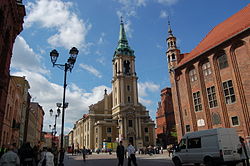Toruń
| Toruń | |||
|---|---|---|---|

Top: Town hall on Stary Rynek
Middle: Dąmbski family Palace, Bridge Gate, Nicolaus Copernicus Monument Bottom: Toruń's medieval Old Town panorama |
|||
|
|||
| Nickname(s): , Gingerbread city, Copernicus Town | |||
| Motto: "Durabo" (Latin: "I will endure") | |||
| Coordinates: 53°2′N 18°37′E / 53.033°N 18.617°E | |||
| Country | Poland | ||
| Voivodeship | Kuyavian-Pomeranian | ||
| County | city county | ||
| Established | 13th century | ||
| City rights | 1233 | ||
| Government | |||
| • Mayor | Michał Zaleski | ||
| Area | |||
| • City | 115.75 km2 (44.69 sq mi) | ||
| Elevation | 65 m (213 ft) | ||
| Population (2014) | |||
| • City | 203,148 | ||
| • Density | 1,800/km2 (4,500/sq mi) | ||
| • Metro | 297,646 | ||
| Time zone | CET (UTC+1) | ||
| • Summer (DST) | CEST (UTC+2) | ||
| Postal code | 87-100 to 87-120 | ||
| Area code(s) | +48 56 | ||
| Car plates | CT | ||
| Website | http://www.torun.pl/ | ||
| Official name | Medieval Town of Toruń | ||
| Type | Cultural | ||
| Criteria | ii, iv | ||
| Designated | 1997 (21st session) | ||
| Reference no. | [1] | ||
| UNESCO region | Europe | ||
| Medieval Town of Toruń | |
|---|---|
| Name as inscribed on the World Heritage List | |
 |
|
| Location | Poland |
| Type | Cultural |
| Criteria | ii, iv |
| Reference | 835 |
| UNESCO region | Europe and North America |
| Inscription history | |
| Inscription | 1997 (21st Session) |
Toruń [ˈtɔruɲ] (German: Thorn) is a city in northern Poland, on the Vistula River. Its population was 202,591 as of June 2016. Toruń is one of the oldest cities in Poland. The medieval old town of Toruń is the birthplace of Polish astronomer Nicolaus Copernicus. In 1997 the medieval part of the city was designated a UNESCO World Heritage Site. In 2007 the Old Town in Toruń was added to the list of Seven Wonders of Poland. Previously it was the capital of the Toruń Voivodeship (1975–98) and the Pomeranian Voivodeship (1921–45). Since 1999, Toruń has been a seat of the self-government of the Kuyavian-Pomeranian Voivodeship and, as such, is one of its two capitals (together with Bydgoszcz). The cities and neighboring counties form the Bydgoszcz-Toruń twin city metropolitan area.
The first settlement in the vicinity of Toruń is dated by archaeologists to 1100 BC (Lusatian culture). During early medieval times, in the 7th through 13th centuries, it was the location of an old Slavonic settlement, at a ford in the Vistula river.
In spring 1231 the Teutonic Knights crossed the river Vistula at the height of Nessau and established a fortress. On 28 December 1233, the Teutonic Knights Hermann von Salza and Hermann Balk, signed the foundation charters for Thorn and Kulm. The original document was lost in 1244. The set of rights in general is known as Kulm law. In 1236, due to frequent flooding, it was relocated to the present site of the Old Town. In 1263 Franciscan monks settled in the city, followed in 1239 by Dominicans. In 1264 the adjacent New Town was founded predominantly to house Torun's growing population of craftsmen and artisans. In 1280, the city (or as it was then, both cities) joined the mercantile Hanseatic League, and thus became an important medieval trade centre.
...
Wikipedia



